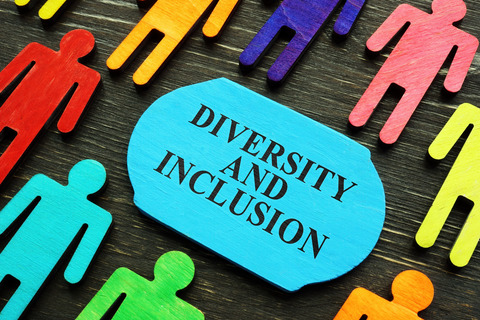10 Ways to be inclusive, and become more effective in projects and meetings
I wrote this article as a response to the lack of inclusiveness I saw while working for large international companies as a consultant. I hope that it will inspire you to help take more action. The article is in English, as I wrote it to inspire other consultants in an international consultancy at the time.
10 Ways to be inclusive, and become more effective in projects and meetings
Today we should all strive to be inclusive since the positive impact of being so is evident.
Yet, we still experience a lack of inclusion across industries and sectors. This article addresses some of the easy ways to be more inclusive.
First of all, why should we include everyone?
We have all experienced it. The meeting is going well, it seems like everyone is agreeing, or at least their arguments seems to fall short. A couple of weeks later, the decision is found to be flawed, and it becomes clear that the reasons behind this were known by participants at the first meeting. Often these did not speak up or could not get their opinions through.
This story shows how lack of inclusion in meetings can lead to ineffectiveness. Inclusion happens from a moral and ethical point of view (64,1% of all board seats in Fortune 100 is Caucasian men), but when looking at pure performance it is also necessary to include everyone to stay ahead of the curve.
The performance follows diversity
A study, “Delivering Through Diversity” from McKinsey, 2017, showed that the companies in the higher quartiles in terms of diversity furthermore possess a higher likelihood of financial performance above the industry median, see the graph below. This was already shown in their study “Why Diversity Matters” from 2014, and as such this is not news, but it is still important and relevant for any organization.

Diversity also strengthens the “Ping-Pong” effect
Companies with high diversity often exhibit a high level of inclusion as well. This increases efficiency as they listen and use all the resources equally, making an organization more successful. Furthermore, the difference in “mind-sets”, which diversity and inclusion bring, also allow for a stronger “ping-pong” with problem-solving or being creative. As such, lack of inclusion means missing out on part of the brainpower, the capacity, and the synergy effects of having diversity.
Why do we not naturally include everybody?
First off, we have prejudices. For instance there is a certain personality type that we often connect to specific gender. In the survey (“Women, Find your voice”, Heath; Flynn; Holt, Harvard Business Review) between 1.100 female executives and 65 male & female CEOs it was found that there was quite a difference in perception between the genders.
The male CEOs saw that women did not speak loud enough or had the ability to break through. 50% of the male CEOs also perceived that women allowed others to interrupt them, apologised and could not present proof to support their arguments. The women felt that they often were alone in the room, due to the low number of women, and that when interrupted it could feel as if they were put “in their place”. In general, the women felt that they had a hard time getting through due to timing and resistance rather than lack of proof.


Different personality types do not necessarily correlate to gender
In the book “Difference Works” by Caroline Turner, two personality types are introduced, Max and Fran. An important point for this is that these are not by default linked to a gender, that linkage is a cultural construct and we should therefore not assume that linkage exists.
Max, the goal oriented and direct personality Max is what often is perceived as masculine: Focus on goals, direct, forceful language, facts before feelings, competition minded, good at communicating directly and when there is time pressure, can be demanding and arrogant, Considers the act of apologizing as a defeat.
Fran, the process-oriented and empathic personality Fran is often perceived as the feminine side: Focus on relations and the process, collaboration is key, questioning, apologetic, good at inviting other opinions and at creating negotiations, considers the act of apologizing as empathy.
These two types are archetypes, and one can move between them and have elements from both at the same time.
However, we often perceive that women who are too much Max are “bossy” and men that are too much Fran are “soft”, which in the aspect of effectiveness are irrelevant observations.
Our standard meeting cultures already are skewed
The idea that you need to be able to cut through in meetings, shows a tendency for the meeting culture to be very Max oriented. You need to be strong, confident, loud and interrupt others to get a saying in many meetings. Information is often given at the meetings, not beforehand, allowing extrovert thinkers to participate lively in the discussions. Meanwhile, the introvert thinkers will not have an opinion until later when they have thought through all the data.
A diverse, inclusive team creates synergies
A good team would have all the aspects involved and have them working together in synergies to optimise the usage of the team. This requires the meeting structure to allow both personality types to be involved on equal grounds. As such inclusion is allowing all personality types to play on even grounds, ignoring or suppressing any prejudices. Simply accepting that no matter race, gender, religion or political standing we are all humans, with different personalities, not connected to those attributes/choices. So, let us level the playing field for all personality types.
10 ways we can level the playing field and create inclusion
To create inclusion there are three areas in which we can actively help level the playing field: internal, environmental, and external.
Each of these is equally important and builds on top of each other.
4 ways to internally help to level the playing field
Internal is the things we can do ourselves. These actions are how we can help ourselves and help others when we are part of the exclusion, knowingly or not.

1. Think before you interrupt
First of all, think before you interrupt. Why are you interrupting? Are you doing it to take over the discussion? How will it make you look to the rest of the room? Often taking over a discussion by force will make you look aggressive and potentially arrogant. If you are doing it to get clarity, mark that you have a question, ask a clear question, and let the speaker continue. If you are doing it because you are afraid to forget your point/question, have paper ready to write it down.
2. Listen actively
If you are having difficulties putting precedences behind you or giving room, try active listening. The basics of it are to try and put yourself in their shoes, listen to their words as if you will have to re-account their exact words, trying to understand how they have reached their current stand-point, even if you disagree. If this is done correctly, you should be able to begin your argument with: “So to summarise your point and argument…” This both helps you include them, and grants you an understanding that can help strengthen your argument.
3. Stop others from interrupting you
If you are getting interrupted, reply with a phrase like “Sorry, I have a couple of more points I would like to make, can you wait a moment,” or “I appreciate your feedback, can you wait with it till I am done, please?“. The sentence needs to be adjusted to the scenario and the people it is attended to. If a specific person is continuously interrupting you, lean forward and look them straight in the eyes when you talk. It is very difficult to interrupt anyone looking you in the eyes and leaning towards the person establishes both focus and power.
4. Presenting your conclusion first/ Top-Down Thinking
When trying to get your argument through it is prudent to start with your conclusion. This will lead the audience to think “Why/How” or something similar, which will allow you to naturally elaborate on your conclusion with arguments and supporting evidence.
Building communication up like this is called Top Down Thinking, a key tool used by many top tier consultancies.
4 ways to create an environment to level the playing field
For all to play even, creating an environment where all are equal is important.
5. Strong policies and aligning expectations
By developing as a group a document that details the group’s expectations to the meeting as a safe space. It should outline that interruption is not allowed, set rules for how the material is distributed, and so forth. This artifact is an important part of setting the scene and giving the individual power to make “call-outs” with the support of the group. It is important that the group is “educated” in the policy and that all are aware of its content. A great way is to make a visual artifact (a rich picture for instance) to put on the wall in the meeting rooms
6. Agenda is sent out beforehand with material
This trivial task is in many organizations not done properly. Sending a detailed agenda before a meeting, together with any material the participants need to digest is best practice. It allows the introvert thinkers (those that do not process information and discuss it on the spot) to process the information and discuss it on equal grounds with the extrovert thinkers. A detailed agenda also allows participants to develop opinions before the meeting and can help to timebox different topics/opinions upfront to allow equally distributed speech time.
7. Small groups can help introverts convey their opinions
In larger meetings, there is a tendency that whoever yells the loudest that is also heard the most. To counteract this tendency, a method can be to divide the room into small groups. In these small groups, one should try to mix extroverts and introverts and encourage all to speak their mind in the group. In this way, the extroverts can share the group’s opinions, and all can be heard by proxy.
8. Appointing a meeting facilitator/leader
It might seem trivial but having an appointed facilitator provides the person with certain powers and responsibilities. It is the facilitator’s job to ensure that all are heard, to sum up the opinions on agenda points before moving on, and to ensure that no one is interrupted. If people are interrupted or not listen to, the facilitator should point this out, gently, and ensure that the opinions are heard. The facilitator should not put people on the spot, like in primary schools, but rather ask if anyone has any other input, and allow silence to reign for a long enough period for people to come with input.
2 ways to externally level the playing field
Having the environment in place, and our internal actions, we can also act externally in the environment to help levelling the playing field.
9. Be aware and call out
Having a clear policy and participants aware of it is a major step. But you also have a responsibility to act on it! Again, it is not about putting people on the spot, but if you feel like the agreement is being violated, you should call it out to the room. This will only foster a safer space where the agreed upon rules are followed.
10. Understand your colleagues and how to support them
As discussed briefly in this article there are several personality types and many more frameworks than the ones covered here. It is important that you understand your colleagues and consider how to support them individually. Remember to give credit when due, to consider if they would prefer feedback in private and in general discuss their preferences with them.
If we all act and help each other level the playing field across organizations, this change can also carry over into other aspects of our lives and those around us, spreading inclusion and diversity.
Let us make the world more inclusive and effective, one meeting at a time.


Drevet af værdier
Elleby Consulting er blevet skabt for at hjælpe dem, der gør en forskel for verdenen. Formålet er at støtte dem, der i sidste ende skal redde den verden, som vi alle skal bo i.
Derfor tilbyder jeg gratis hjælp og rådgivning til alle, der gør en forskel!